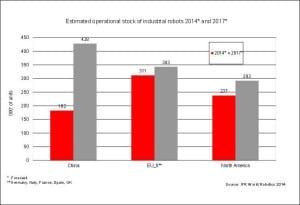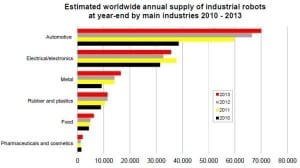 Consumer media may focus on humanoid robots staffing hotels in Japan, but industrial robots are the bread and butter of the robotics industry at present.
Consumer media may focus on humanoid robots staffing hotels in Japan, but industrial robots are the bread and butter of the robotics industry at present.
Most of us know this. We’re aware that robots have been used in automotive plants for decades. In 1913, Henry Ford’s ‘conveyor belt’ production line turned automotive manufacturing into a set of standardised, repetitive steps. Exactly the kind of activity where human creativity, flexibility and responsiveness have little to add, but human variation and carelessness can lower quality. The car industry has been at the forefront of industrial robotics ever since.
What’s more interesting is to look at how industrial robots are spreading – to other industry sectors, and across various geographies.
Spread of industrial robots in key manufacturing countries
 Robotics has traditionally been centred in Japan, the USA and Germany – all countries with strong automotive industries. Figures from 2013 show these countries still have the most industrial robots installed, but the picture is more complicated than that.
Robotics has traditionally been centred in Japan, the USA and Germany – all countries with strong automotive industries. Figures from 2013 show these countries still have the most industrial robots installed, but the picture is more complicated than that.
First, look at the ratio of industrial robots to industrial workers. By this standard, South Korea is by far the most robotised country. China, on the other hand, looks to be just starting out. So why are we talking about industrial robots in China?
 Because in 2013 around 20% of all new robots sales globally were to China.
Because in 2013 around 20% of all new robots sales globally were to China.
Because the recently published World Robotics 2014 Industrial Robots global study concludes that the Chinese robot market will double in the next three years.
Because by 2017, more industrial robots will be operating in China’s production plants than in the European Union or North America.
It’s a far cry from the traditional image of Chinese manufacturing. We tend to think of women huddled over sewing machines, or carefully assembling delicate computer chips. But Chinese manufacturing is much more varied than that. And steadily increasing wages have made robots more cost-competitive.
Data from the China Robot Industry Alliance in 2013 shows only a quarter of robots sold in China (around 9,000) were from local suppliers. At this point, China is still dependent on overseas companies for its robots – but that is changing. In 2014, China’s Ministry of Industry announced a five-year plan to promote the robotics sector. The goal is to achieve a 45% share of the high-end robot market by 2020. And foreign robotics companies are also setting up production in China.
What does the increasing use of industrial robots in China mean for Chinese manufacturing and sourcing? It may mean more consistent quality and modifications to quality control processes. But only if suppliers are using robots, and that will depend on the industry sector.
Industrial Robots by Industry
 Statistics from the International Federation of Robotics show the automotive sector continues as a major market. There is a natural transition from automotive to the next biggest market – electrical and electronics.
Statistics from the International Federation of Robotics show the automotive sector continues as a major market. There is a natural transition from automotive to the next biggest market – electrical and electronics.
Adoption of industrial robots in metal production has almost doubled in the last four years. The pharmaceutical and cosmetics industry is also starting to adopt robots, although from a very small base. One driver may be the development of articulated robots, which can do more sophisticated tasks, including assembly, welding, loading and unloading.
***
So what’s the Hornet view on Chinese suppliers who use industrial robots? For us, it’s interesting, but not the key factor. Robots do not necessarily produce better quality or cheaper rates. If the manufacturer relies on them too much and doesn’t check quality, they may in fact make matters worse! So when we’re assessing potential suppliers for our clients, Hornet will continue to focus on the basics. Capability. Suitability. Responsiveness. Reliability. Cost effectiveness. And that wonderful proactivity we love to get from everyone we deal with.
